1000+ Animal Kingdom MCQ for RRB JE [Solved]
Thursday 9th of March 2023

Sharing is caring
1. Examine the figures A, B and C. In which one of the four options all the items A, B and C are correctly identified ?

A. A - Sycon, B - Euspongia, C - Spongilla
B. A - Euspongia, B - Spongilla, C - Sycon
C. A - Spongilla, B - Sycon, C - Euspongia
D. A - Euspongia, B - Sycon, C - Spongilla
Answer : A

A. A - Sycon, B - Euspongia, C - Spongilla
B. A - Euspongia, B - Spongilla, C - Sycon
C. A - Spongilla, B - Sycon, C - Euspongia
D. A - Euspongia, B - Sycon, C - Spongilla
Answer : A
2. Match the terms/feature given in column I with their examples given in column II and select the correct match from the option given below.
A. A - i, B - ii, C - iii, D - iv, E - v
B. A - iii, B - v, C - ii, D - iv, E - i
C. A - iii, B - i, C - v, D - ii, E - iv
D. A - v, B - iv, C - iii, D - i, E - ii
Answer : D
| Column-I | Column-II |
|---|---|
| (Term/Feature) | (Examples) |
| A. Gregarious pest | i. Hirudinaria |
| B. Vector | ii. Planaria |
| C. Oviparous with | iii. Sepia indirect development |
| D. Metameres | iv. Aedes |
| E. High regeneration | v. Locust capacity |
A. A - i, B - ii, C - iii, D - iv, E - v
B. A - iii, B - v, C - ii, D - iv, E - i
C. A - iii, B - i, C - v, D - ii, E - iv
D. A - v, B - iv, C - iii, D - i, E - ii
Answer : D
3. Match the characteristic feature/terms given in column I with the phylum to which they belongs given in column II and choose the correct option.
A. A II; B I; C IV; D V; E III
B. A II; B IV; C I; D V; E III
C. A V; B I; C III; D II; E IV
D. A III; B IV; C I; D V; E II
Answer : D
| Column-I | Column-II |
|---|---|
| (Characteristic feature/term) | (Phylum) |
| A. Choanocytes | I. Platyhelminthes |
| B. Cnidoblasts | II. Ctenophora |
| C. Flame cells | III. Porifera |
| D. Nephridia | IV. Coelenterata |
| E. Comb plates | V. Annelida |
A. A II; B I; C IV; D V; E III
B. A II; B IV; C I; D V; E III
C. A V; B I; C III; D II; E IV
D. A III; B IV; C I; D V; E II
Answer : D
4. Which of the following pairs of animals comprises jawless fishes?
A. Mackerals and rohu
B. Lampreys and hag fishes
C. Guppies and hag fishes
D. Lampreys and eels
Answer : B
A. Mackerals and rohu
B. Lampreys and hag fishes
C. Guppies and hag fishes
D. Lampreys and eels
Answer : B
5. Which of the following group of animals belongs to the same phylum?
A. Earthworm, pinworm, tapeworm
B. Prawn, scorpion, Locusta
C. Sponge, Sea anemone, starfish
D. Malarial parasite, Amoeba, mosquito
Answer : B
A. Earthworm, pinworm, tapeworm
B. Prawn, scorpion, Locusta
C. Sponge, Sea anemone, starfish
D. Malarial parasite, Amoeba, mosquito
Answer : B
6. In phylum arthropoda, excretion takes place through
A. nephridia
B. flame cells
C. malphigian tubules
D. gills
Answer : C
A. nephridia
B. flame cells
C. malphigian tubules
D. gills
Answer : C
7. The figure given below shows the germinal layers marked as A, B, C and D. Identify the label showing undifferentiated layer and its location?
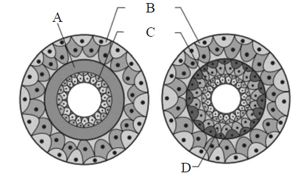
A. A, Between B & C
B. B, Between A & C
C. C, Between C & D
D. D, Between A & B
Answer : A

A. A, Between B & C
B. B, Between A & C
C. C, Between C & D
D. D, Between A & B
Answer : A
8. In amphibians, heart is ________ chambered.
A. two
B. three
C. four
D. none of these
Answer : B
A. two
B. three
C. four
D. none of these
Answer : B
9. Which of the following feature is not correct regarding the figure given below?

A. It is an aquatic form.
B. Circulatory system is of open type.
C. It possesses parapodia for swimming.
D. Neural system consists of paired ganglia connected by lateral nerves to a double ventral nerve cord.
Answer : B

A. It is an aquatic form.
B. Circulatory system is of open type.
C. It possesses parapodia for swimming.
D. Neural system consists of paired ganglia connected by lateral nerves to a double ventral nerve cord.
Answer : B
10. Select the incorrect feature of mollusca from the given statements.
A. (i) and (ii) only
B. (ii) and (iv) only
C. (i), (ii) and (iv) only
D. All the five statements.
Answer : C
- Terrestrial or aquatic animals having cellular system level of organization.
- Radial symmetrical and acoelomate animals and possesses two germinal layers.
- A file like rasping organ called radula is present.
- Usually dioecious and viviparous animals.
- Examples include Pila, Octopus, and Dentalium.
A. (i) and (ii) only
B. (ii) and (iv) only
C. (i), (ii) and (iv) only
D. All the five statements.
Answer : C
11. When any plane passing through the central axis of the body divides the organism into two identical halves, the organism is called ___________.
A. radially symmetrical
B. bilaterally symmetrical
C. asymmetrical
D. metamerically segmented
Answer : A
A. radially symmetrical
B. bilaterally symmetrical
C. asymmetrical
D. metamerically segmented
Answer : A
12. A common characteristic of all vertebrates without exception is
A. the division of body into head, neck, trunk and tail.
B. body covered with exoskeleton.
C. the possession of two pairs of functional appendages.
D. the presence of well- developed skull.
Answer : D
A. the division of body into head, neck, trunk and tail.
B. body covered with exoskeleton.
C. the possession of two pairs of functional appendages.
D. the presence of well- developed skull.
Answer : D
13. The given figures (A & B) shows the germinal layer. The animals having structures shown in the figures are respectively called

A. diploblastic, triploblastic
B. triploblastic, diploblastic
C. diploblastic, diploblastic
D. triploblastic, triploblastic
Answer : A

A. diploblastic, triploblastic
B. triploblastic, diploblastic
C. diploblastic, diploblastic
D. triploblastic, triploblastic
Answer : A
14. Identify the animals shown in the given figures A, B and C from options given below.

A. A - Octopus; B -Asterias, C- Ophiura
B. A - Asterias; B - Ophiura, C- Octopus
C. A - Echinus; B - Octopus C - Ophiura
D. A - Ophiura; B - Echinus, C- Octopus
Answer : A

A. A - Octopus; B -Asterias, C- Ophiura
B. A - Asterias; B - Ophiura, C- Octopus
C. A - Echinus; B - Octopus C - Ophiura
D. A - Ophiura; B - Echinus, C- Octopus
Answer : A
15. Refer the given figures A, B, C and D and identify the option which shows their correct name.
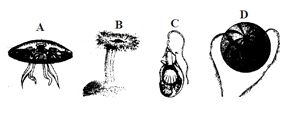
A. A - Pleurobrachia, B - Cnidoblast, C - Aurelia, D - Adamsia
B. A - Aurelia, B - Adamsia C - Cnidoblast, D - Pleurobrachia
C. A - Cnidoblast, B - Pleurobrachia, C - Adamsia, D - Aurelia
D. A - Adamsia, B - Aurelia, C - Pleurobrachia, D - Cnidoblast
Answer : B

A. A - Pleurobrachia, B - Cnidoblast, C - Aurelia, D - Adamsia
B. A - Aurelia, B - Adamsia C - Cnidoblast, D - Pleurobrachia
C. A - Cnidoblast, B - Pleurobrachia, C - Adamsia, D - Aurelia
D. A - Adamsia, B - Aurelia, C - Pleurobrachia, D - Cnidoblast
Answer : B
16. Aquatic annelids (like Nereis) possess lateral appendages called ______________, which help in swimming.
A. visceral hump
B. parapodia
C. radula
D. spicules
Answer : B
A. visceral hump
B. parapodia
C. radula
D. spicules
Answer : B
17. Read the following statements and answer the question.
(i) They are exclusively marine, radially symmetrical, diploblastic organisms with tissue level of organisation.
(ii) Body bears eight external rows of ciliated comb plates, which help in locomotion.
(iii) Digestion is both extracellular and intracellular.
(iv) Reproduction takes place only by sexual means.
Which of the following phylum is being described by above statements?
A. Platyhelminthes
B. Arthropoda
C. Mollusca
D. Ctenophora
Answer : D
(i) They are exclusively marine, radially symmetrical, diploblastic organisms with tissue level of organisation.
(ii) Body bears eight external rows of ciliated comb plates, which help in locomotion.
(iii) Digestion is both extracellular and intracellular.
(iv) Reproduction takes place only by sexual means.
Which of the following phylum is being described by above statements?
A. Platyhelminthes
B. Arthropoda
C. Mollusca
D. Ctenophora
Answer : D
18. Which of the following sets of animals give birth to young ones?
A. Platypus, Penguin, Bat, Hippopotamus.
B. Shrew, Bat, Cat, Kiwi.
C. Kangaroo, Hedgehog, Dolphin, Loris.
D. Lion, Bat, Whale, Ostrich.
Answer : C
A. Platypus, Penguin, Bat, Hippopotamus.
B. Shrew, Bat, Cat, Kiwi.
C. Kangaroo, Hedgehog, Dolphin, Loris.
D. Lion, Bat, Whale, Ostrich.
Answer : C
19. Which of the following class is being described by the given statements (i - iv)?
(i) They are found in a variety of habitats- polar ice-caps, deserts, mountains, forests, grasslands and dark caves.
(ii) Most unique mammalian characteristic is the presence of mammary glands by which the young ones are nourished.
(iii) Heart is four-chambered.
(iv) Sexes are separate and fertilization is internal.
A. Reptilia
B. Aves
C. Mammalia
D. Amphibia
Answer : C
(i) They are found in a variety of habitats- polar ice-caps, deserts, mountains, forests, grasslands and dark caves.
(ii) Most unique mammalian characteristic is the presence of mammary glands by which the young ones are nourished.
(iii) Heart is four-chambered.
(iv) Sexes are separate and fertilization is internal.
A. Reptilia
B. Aves
C. Mammalia
D. Amphibia
Answer : C
20. The figure given below is the characteristic structure of the phylum in which animals are aquatic, free swimming or sessile, mostly marine, radially symmetrical. Identify the phylum and correct function of the structure.

A. Ctenophora; Emission of light.
B. Porifera; Feeding, respiration and excretion.
C. Cnidarian; Anchorage, Defense and food capturing
D. Mollusca; Locomotion, transport of food and respiration.
Answer : C

A. Ctenophora; Emission of light.
B. Porifera; Feeding, respiration and excretion.
C. Cnidarian; Anchorage, Defense and food capturing
D. Mollusca; Locomotion, transport of food and respiration.
Answer : C
21. In ctenophora, the body bears _______ external rows of ciliated comb plates, which help in locomotion.
A. five
B. six
C. seven
D. eight
Answer : D
A. five
B. six
C. seven
D. eight
Answer : D
22. Refer the following statement and answer the question. 'Name of X is derived from stinging capsules. It exhibits metagenesis containing two body forms in which sessile and cylindrical form is called Y and umbrella shaped and free swimming is called Z. Identify X, Y, and Z.
A. X - Coelenterate, Y - Polyp, Z - Medusa
B. X - Cnidarian, Y - Medusa, Z - Polyp
C. X - Ctenophora, Y - Radula, Z - Hypostome
D. X - Porifera, Y - Osculum, Z - Radula
Answer : A
A. X - Coelenterate, Y - Polyp, Z - Medusa
B. X - Cnidarian, Y - Medusa, Z - Polyp
C. X - Ctenophora, Y - Radula, Z - Hypostome
D. X - Porifera, Y - Osculum, Z - Radula
Answer : A
23. Which of the following is a fresh water sponge?
A. Sycon
B. Euspongia
C. Spongilla
D. Pleurobrachia
Answer : C
A. Sycon
B. Euspongia
C. Spongilla
D. Pleurobrachia
Answer : C
24. Which of the following characteristics is correct for reptilia?
A. Body covered with dry and cornified skin, scales over the body are epidermal, they do not have external ears.
B. Body is covered with moist skin and is devoid of scales, the ear is represented by a tympanum, alimentary canal, urinary and reproductive tracts open into a common cloaca.
C. Fresh water animals with bony endoskeleton and airbladder regulate buoyancy.
D. Marine animals with cartilaginous endoskeleton and body is covered with placoid scales.
Answer : A
A. Body covered with dry and cornified skin, scales over the body are epidermal, they do not have external ears.
B. Body is covered with moist skin and is devoid of scales, the ear is represented by a tympanum, alimentary canal, urinary and reproductive tracts open into a common cloaca.
C. Fresh water animals with bony endoskeleton and airbladder regulate buoyancy.
D. Marine animals with cartilaginous endoskeleton and body is covered with placoid scales.
Answer : A
25. Which of the following traits is not shared by both sea anemones and jellyfish ?
A. A medusa as the dominant stage in the life cycle.
B. Possession of a gastro vascular cavity.
C. Sexual reproduction.
D. Nematocysts present on the tentacles.
Answer : A
A. A medusa as the dominant stage in the life cycle.
B. Possession of a gastro vascular cavity.
C. Sexual reproduction.
D. Nematocysts present on the tentacles.
Answer : A
26. Refer the figures A, B, C and D given below. Which of the following options shows the correct name of the animals shown by the figures A, B, C and D ?

A. A – Locust, B – Scorpion, C – Prawn, D – Pila
B. A – Locust, B – Prawn, C – Scorpion, D – Pila
C. A – Locust, B – Scorpion, C – Prawn, D – Snail
D. A – Butterfly, B – Scorpion, C – Prawn, D – Pila
Answer : A

A. A – Locust, B – Scorpion, C – Prawn, D – Pila
B. A – Locust, B – Prawn, C – Scorpion, D – Pila
C. A – Locust, B – Scorpion, C – Prawn, D – Snail
D. A – Butterfly, B – Scorpion, C – Prawn, D – Pila
Answer : A
27. Flame cells present in platyhelminthes, are specialized in
A. respiration and absorption.
B. osmoregulation and circulation.
C. respiration and excretion.
D. osmoregulation and excretion.
Answer : D
A. respiration and absorption.
B. osmoregulation and circulation.
C. respiration and excretion.
D. osmoregulation and excretion.
Answer : D
28. Which of the following statement(s) is/are correct regarding phylum aschelminthes?
(i) The body is circular in cross-section hence the name roundworms.
(ii) Alimentary canal is complete with a well-developed muscular pharynx.
(iii) Sexes are separate (dioecious), i.e., males and females are distinct.
(iv) Nephridia help in osmoregulation and excretion.
A. (i) and (ii)
B. (iii) and (iv)
C. (i), (ii) and (iii)
D. All of these
Answer : C
(i) The body is circular in cross-section hence the name roundworms.
(ii) Alimentary canal is complete with a well-developed muscular pharynx.
(iii) Sexes are separate (dioecious), i.e., males and females are distinct.
(iv) Nephridia help in osmoregulation and excretion.
A. (i) and (ii)
B. (iii) and (iv)
C. (i), (ii) and (iii)
D. All of these
Answer : C
29. Which of the following statements (i v) are incorrect?
(i) Parapodia are lateral appendages in arthropods used for swimming.
(ii) Radula in molluscs are structures involved in excretion.
(iii) Aschelminthes are dioecious.
(iv) Echinoderm adults show radial symmetry.
(v) Ctenophorans are diploblastic.
A. (i) and (ii)
B. (i) and (iii)
C. (i), (iv) and (v)
D. (iii) and (v)
Answer : A
(i) Parapodia are lateral appendages in arthropods used for swimming.
(ii) Radula in molluscs are structures involved in excretion.
(iii) Aschelminthes are dioecious.
(iv) Echinoderm adults show radial symmetry.
(v) Ctenophorans are diploblastic.
A. (i) and (ii)
B. (i) and (iii)
C. (i), (iv) and (v)
D. (iii) and (v)
Answer : A
30. Identify the correct characteristics of porifera.
A. (ii), (v) only
B. (i), (ii), (vi) only
C. (i), (ii), (iii), (iv) only
D. All of these.
Answer : A
- Commonly known as sea walnuts.
- Presence of ostia and collar cells.
- Exhibit tissue level of characteristics.
- It is the largest phylum of animal kingdom.
- he body is supported by spicules and sponging fibers.
- Contains cnidocytes which is used for defense, anchorage and capturing of prey.
A. (ii), (v) only
B. (i), (ii), (vi) only
C. (i), (ii), (iii), (iv) only
D. All of these.
Answer : A
31. Identify the figure with its correct name and phylum.
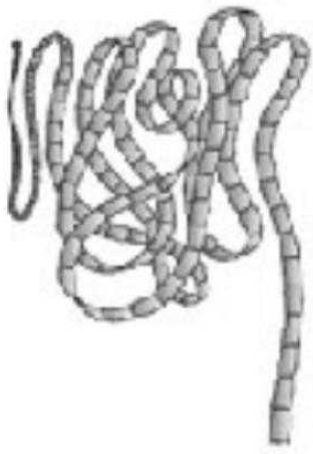
A. Sycon - Porifera
B. Aurelia - Coelenterata
C. Pleurobrachia - Ctenophora
D. Tapeworm - Platyhelminthes
Answer : D

A. Sycon - Porifera
B. Aurelia - Coelenterata
C. Pleurobrachia - Ctenophora
D. Tapeworm - Platyhelminthes
Answer : D
32. Tracheae of cockroach and mammal are similar in having
A. paired nature.
B. non-collapsible walls.
C. ciliated inner lining.
D. origin from head.
Answer : B
A. paired nature.
B. non-collapsible walls.
C. ciliated inner lining.
D. origin from head.
Answer : B
33. The combination of a true coelom and repeating body segmentation allows the annelids (unlike the anatomically simpler worms) to do which of the following?
A. Attain complex body shapes and thus locomote more precisely.
B. Move through loose marine sediments.
C. Be hermaphroditic.
D. Inject paralytic poisons into their prey.
Answer : A
A. Attain complex body shapes and thus locomote more precisely.
B. Move through loose marine sediments.
C. Be hermaphroditic.
D. Inject paralytic poisons into their prey.
Answer : A
34. The organisms attached to the substratum generally possess
A. one single opening to the digestive canal.
B. cilia on the surface to create water current.
C. radial symmetry.
D. asymmetrical body.
Answer : C
A. one single opening to the digestive canal.
B. cilia on the surface to create water current.
C. radial symmetry.
D. asymmetrical body.
Answer : C
35. Refer the figures A, B and C and choose the correct option which shows animals that regulate buoyancy with the help of air bladder.
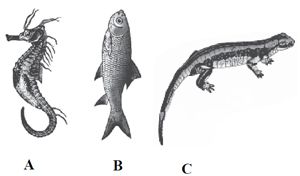
A. A and B
B. A and C
C. B and C
D. All of the above.
Answer : A

A. A and B
B. A and C
C. B and C
D. All of the above.
Answer : A
36. Which of the following phylum is being described by the given statements?
(i) These are primitive multicellular animals and have cellular level of organization.
(ii) Digestion is intracellular.
(iii) They have a water transport or canal system.
(iv) They reproduce asexually by fragmentation and sexually by formation of gametes.
A. Porifera
B. Ctenophora
C. Coelenterata
D. Platyhelminthes
Answer : A
(i) These are primitive multicellular animals and have cellular level of organization.
(ii) Digestion is intracellular.
(iii) They have a water transport or canal system.
(iv) They reproduce asexually by fragmentation and sexually by formation of gametes.
A. Porifera
B. Ctenophora
C. Coelenterata
D. Platyhelminthes
Answer : A
37. Match the phylum given in column - I with their example given in column - II and choose the correct option.
A. A IV; B II; C I; D III
B. A II; B IV; C I; D III
C. A II; B IV; C III; D I
D. A II; B I; C IV; D III
Answer : B
| Column -I | Column- II |
|---|---|
| (Phylum) | (Examples) |
| A. Echinodermata | I. Ascidia, Doliolum |
| B. Hemichordata | II. Asterias, Ophiura |
| C. Urochordata | III. Branchiostoma |
| D. Cephalochordata | IV. Balanoglossus, Saccoglossus |
A. A IV; B II; C I; D III
B. A II; B IV; C I; D III
C. A II; B IV; C III; D I
D. A II; B I; C IV; D III
Answer : B
38. Match the features given in column I with their examples given in column II and choose the correct match from the option given below.
A. A - e, B - b, C - d, D - c, E - a
B. A - c, B - a, C - d, D - b, E - e
C. A - b, B - a, C - c, D - e, E - d
D. A - c, B - b, C - d, D - a, E - e
Answer : B
| Column-I | Column-II |
|---|---|
| (Features) | (Examples) |
| A. Pseudocoelomates | a. Hydra, Adamsia |
| B. Diploblastic | b. Ctenoplana, Aurelia |
| C. Cellular level of | c. Ascaris, Wuchereria organization |
| D. Radial symmetry | d. Sycon, Spongilla |
| E. Metamerism | e. Pheretima, Neries |
A. A - e, B - b, C - d, D - c, E - a
B. A - c, B - a, C - d, D - b, E - e
C. A - b, B - a, C - c, D - e, E - d
D. A - c, B - b, C - d, D - a, E - e
Answer : B
39. In which of the phylum, excretory organ like proboscis gland is present?
A. Hemichordata
B. Chordata
C. Echinodermata
D. Annelida
Answer : A
A. Hemichordata
B. Chordata
C. Echinodermata
D. Annelida
Answer : A
40. Which of the following statements (i - v) are correct ?
(i) The pelvic fins of female sharks bear claspers.
(ii) In Obelia, polyps produce medusae sexually and medusae form the polyps asexually.
(iii) Flame cells in platyhelminthes help in osmoregulation and excretion.
(iv) In non-chordates, central nervous system is ventral, solid and double.
(v) Pinnae are present in mammals.
A. (ii), (iv) and (v)
B. (i), (iii) and (v)
C. (iii), (iv) and (v)
D. (i), (ii) and (iii)
Answer : C
(i) The pelvic fins of female sharks bear claspers.
(ii) In Obelia, polyps produce medusae sexually and medusae form the polyps asexually.
(iii) Flame cells in platyhelminthes help in osmoregulation and excretion.
(iv) In non-chordates, central nervous system is ventral, solid and double.
(v) Pinnae are present in mammals.
A. (ii), (iv) and (v)
B. (i), (iii) and (v)
C. (iii), (iv) and (v)
D. (i), (ii) and (iii)
Answer : C
41. Which of the following phylum is being described by the given statements?
(i) They are bilaterally symmetrical,triploblastic, segmented and coelomate animals.
(ii) The body consists of head, thorax, abdomen and have jointed appendages.
(iii) Circulatory system is of open type.
(iv) Excretion takes place through malphigian tubules.
A. Arthropoda
B. Annelida
C. Mollusca
D. Echinodermata
Answer : A
(i) They are bilaterally symmetrical,triploblastic, segmented and coelomate animals.
(ii) The body consists of head, thorax, abdomen and have jointed appendages.
(iii) Circulatory system is of open type.
(iv) Excretion takes place through malphigian tubules.
A. Arthropoda
B. Annelida
C. Mollusca
D. Echinodermata
Answer : A
42. Identify the figure with its correct name and phylum.

A. Cucumaria – Echinodermata
B. Ascidia – Urochordata
C. Balanoglossus – Hemichordata
D. Hirudinaria – Annelida
Answer : C

A. Cucumaria – Echinodermata
B. Ascidia – Urochordata
C. Balanoglossus – Hemichordata
D. Hirudinaria – Annelida
Answer : C
43. Identify the figures A, B and C and choose the correct option.

A. A - Male Ascaris, B - Hirudinaria (leech), C- Nereis
B. A - Female Ascaris, B - Nereis, C-Hirudinaria (leech)
C. A - Female Ascaris B- Hirudinaria (leech), C - Nereis
D. A - Male Ascaris, B - Nereis, C- Hirudinaria (leech)
Answer : B

A. A - Male Ascaris, B - Hirudinaria (leech), C- Nereis
B. A - Female Ascaris, B - Nereis, C-Hirudinaria (leech)
C. A - Female Ascaris B- Hirudinaria (leech), C - Nereis
D. A - Male Ascaris, B - Nereis, C- Hirudinaria (leech)
Answer : B
44. Match the types of animals given in column I with their examples given in column II and choose the correct option.
A. A II; B V; C IV; D I; E III
B. A V; B II; C IV; D I; E III
C. A V; B II; C I; D IV; E III
D. A V; B IV; C II; D I; E III
Answer : B
| Column -I | Column -II |
|---|---|
| (Types of animals) | (Examples) |
| A. Limbless reptiles | I. Elephant |
| B. Jawless vertebrates | II. Lamprey |
| C. Flightless bird | III. Ichthyophis |
| D. Largest | IV. Ostrich terrestrial animal |
| E. Limbless amphibia | V. Cbra |
A. A II; B V; C IV; D I; E III
B. A V; B II; C IV; D I; E III
C. A V; B II; C I; D IV; E III
D. A V; B IV; C II; D I; E III
Answer : B
45. Which of the following is not the common fundamental feature for animal classification?
A. Germinal layers.
B. Pathway of water transport.
C. Pattern of organization of cells.
D. Serial repetition of the segments.
Answer : B
A. Germinal layers.
B. Pathway of water transport.
C. Pattern of organization of cells.
D. Serial repetition of the segments.
Answer : B
46. Identify the figures and select the correct option
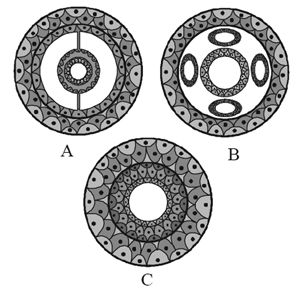
A. A - Pseudocoelomate; B - Coelomate, C-Acoelomate
B. A - Coelomate, B - Pseudocoelomate, C- Acoelomate
C. A - Coelomate; B- Acoelomate; C - Pseudocoelomate
D. A - Coelomate; B- Acoelomate; C-Eucoelomate
Answer : B

A. A - Pseudocoelomate; B - Coelomate, C-Acoelomate
B. A - Coelomate, B - Pseudocoelomate, C- Acoelomate
C. A - Coelomate; B- Acoelomate; C - Pseudocoelomate
D. A - Coelomate; B- Acoelomate; C-Eucoelomate
Answer : B
47. Column-I contains organisms and column-II contains their exeretory structures. Choose the correct match form the options given below.
A. A I; B III; C II; D IV; E V
B. A III; B I; C II; D V; E IV
C. A II; B I; C III; D V; E IV
D. A II; B III; C I; D V; E IV
Answer : D
| Column- I | Column -II |
|---|---|
| (Organism) | (Excretory structures) |
| A. Cockroach | I. Nephridia |
| B. Cat fish | II. Malpighian tubules |
| C. Earthworm | III. Kidneys |
| D. Balanoglossus | IV. Flame cells |
| E. Flatworm | V. Proboscis gland |
A. A I; B III; C II; D IV; E V
B. A III; B I; C II; D V; E IV
C. A II; B I; C III; D V; E IV
D. A II; B III; C I; D V; E IV
Answer : D
48. Which of the following belong to phylum arthropoda?
A. Bombyx and Apis
B. Laccifer and Anopheles
C. Locusta and Limulus
D. All of the above
Answer : D
A. Bombyx and Apis
B. Laccifer and Anopheles
C. Locusta and Limulus
D. All of the above
Answer : D
49. In phylum echinodermata, the adult echinoderms are ______A__________ but larvae are _______B______ .
A. A radially symmetrical; B bilaterally symmetrical
B. A bilaterally symmetrical; B radially symmetrical
C. A bilaterally symmetrical; B asymmetrical
D. A metamerically segmented; B asymmetrical
Answer : A
A. A radially symmetrical; B bilaterally symmetrical
B. A bilaterally symmetrical; B radially symmetrical
C. A bilaterally symmetrical; B asymmetrical
D. A metamerically segmented; B asymmetrical
Answer : A
50. Which of the following group of animals reproduces only by sexual means?
A. Ctenophora
B. Cnidaria
C. Porifera
D. Protozoa
Answer : A
A. Ctenophora
B. Cnidaria
C. Porifera
D. Protozoa
Answer : A
Sharing is caring
Related Post
IIFT - Php Programming 1000+ MCQ [Solved] PDF Download
Clause Analysis MCQ Solved Paper for NMAT
SSC JHT - JavaScript 1000+ MCQ [Solved] PDF Download
LIC ADO - Urothelial tumors of the upper & lower urinary tracts 1000+ MCQ [Solved] PDF Download
Periodic Classification of Elements MCQ Solved Paper for IBPS PO
1000+ C Programming Multiple Choice Question Answer [Solved]